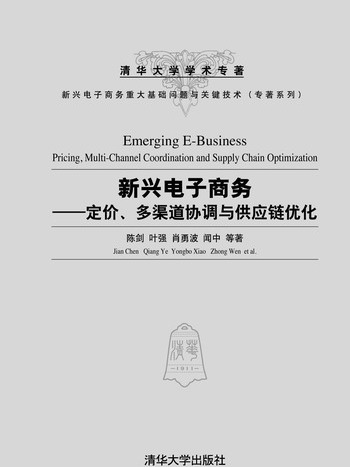《新興電子商務——定價、多渠道協調與供應鏈最佳化》是2013年10月清華大學出版社出版的圖書,作者是陳劍、葉強、肖勇波、聞中、竇一凡、張、菊亮、關磊、李岩。
基本介紹
- 中文名:新興電子商務——定價、多渠道協調與供應鏈最佳化
- 作者:陳劍、葉強、肖勇波、聞中、竇一凡、張、菊亮、關磊、李岩
- 出版社:清華大學出版社
- 出版時間:2013年10月
- 定價:96 元
- ISBN:9787302331841
內容簡介,圖書目錄,
內容簡介
新興電子商務與傳統電子商務相比,呈現出移動性(如泛在互聯、移動商務)、虛擬性(如虛擬體驗、賽博空間)、個性化(如精準行銷、推薦服務)、社會性(如社交媒體、社會商務)、極端數據(如富媒體、大數據)等鮮明特徵。本書圍繞新興電子商務若干重要理論與套用課題,從市場結構和商業模式的角度入手,展現在電子商務環境下市場組織機制、渠道設計與系統、定價策略與最佳化、線上評論管理以及相關庫存管理等方面的研究成果。研究內容緊扣現實問題,通過科學凝練和系統性建模,旨在為學界和業界提供運營模式和最佳化與協調策略等方面的啟示,也為相關研究提供了實證分析的思路和建模方法。
本書主要面向高校和科研單位的碩士生、博士生和學者,對企業套用和研發人員也具有參考價值。
圖書目錄
第1章引言
1.1新興電子商務背景下探討商務模式的重要性
1.2新興電子商務技術帶給傳統商務模式的影響
1.2.1虛擬性對於商務模式的影響
1.2.2移動性對於商務模式的影響
1.2.3極端數據對於商務模式的影響
1.2.4個性化對於商務模式的影響
1.2.5社會化對於商務模式的影響
1.3本書的內容安排簡介
第2章B2B電子交易市場採納關鍵影響因素研究
2.1B2B電子交易市場商業模式
2.1.1B2B電子交易市場的類型
2.1.2B2B電子交易市場的價值
2.1.3B2B電子交易市場的風險
2.1.4B2B電子交易市場採納現狀及研究意義
2.2理論背景及研究模型
2.2.1關係交換理論
2.2.2交易成本理論
2.2.3研究模型
2.3研究假設
2.3.1關係交換視角因素
2.3.2交易成本視角因素
2.4研究方法
2.4.1德爾菲檢驗
2.4.2德爾菲檢驗過程
2.4.3研究樣本
2.5研究結果
2.6結果討論
2.6.1關係交換視角
2.6.2交易成本視角
2.7本章小結
第3章雙邊市場研究
3.1雙邊市場介紹
3.1.1雙邊市場概述
3.1.2雙邊市場的特點
3.1.3雙邊市場研究的意義
3.2主要研究問題
3.2.1定價
3.2.2平台競爭
3.2.3動態競爭戰略
3.3B2B市場的結構、所有權和福利
3.4眾包市場的定價機制
3.5本章小結
第4章信息搜尋和廣告
4.1研究背景
4.1.1廣告與網際網路
4.1.2網際網路廣告技術
4.1.3度量廣告效果
4.2相關理論
4.2.1搜尋理論
4.2.2廣告理論
4.2.3信息中介
4.3流量競爭和搜尋
4.4本章小結
第5章信息產品定價策略研究
5.1引言
5.1.1研究信息產品的定價問題的目的
5.1.2信息產品定價的要點
5.1.3信息產品定價的研究進展
5.2典型研究問題概述
5.2.1版本定價問題
5.2.2信息產品競爭
5.3網路外部性和免費發放策略
5.3.1模型介紹
5.3.2最優策略求解
5.4信息產品定價機制選擇
5.4.1模型介紹
5.4.2最優策略求解
5.4.3啟發式定價策略
5.5本章小結
第6章團購定價研究
6.1本章引言
6.1.1電子商務與團購定價模式
6.1.2團購定價的研究視角
6.1.3本章內容簡介
6.2文獻
6.2.1拍賣理論的相關研究
6.2.2數量折扣機制的相關研究
6.3經典模型
6.3.1最初的實證研究
6.3.2購買者投標策略研究
6.3.3賣方定價策略研究
6.4投標者合作策略研究
6.5B2B環境下的訂貨、定價策略研究
6.6第二代團購定價模式銷售策略研究
6.7本章小結
第7章線上評論的管理分析方法(技術導向)
7.1緒論
7.1.1研究背景
7.1.2研究進展概述
7.2線上評論情感分析相關理論
7.2.1線上評論情感分類概念
7.2.2基於監督學習的評論情感分類原理
7.2.3基於語義的評論情感分類原理
7.3基於監督學習的中文評論情感分類研究
7.3.1基於矢量空間模型的評論情感分類
7.3.2基於字元語言模型的評論情感分類
7.3.3兩種模型的評論情感分類實驗
7.4基於語義的中文評論情感分類研究
7.4.1中文評論PMIIR情感分類研究
7.4.2基於Snippet的中文評論情感分類研究
7.4.3Snippet與PMIIR的中文評論情感分類比較
7.5總結和未來展望
第8章線上評論對企業績效及客戶滿意度的影響
8.1引言
8.1.1研究背景
8.1.2基本概念
8.2研究背景概述
8.2.1線上評論對企業績效影響的相關研究
8.2.2線上評論影響用戶感知有用性的相關研究
8.2.3線上管理反饋的相關研究
8.3線上評論對酒店線上預訂量影響的實證研究
8.3.1模型及假設的提出
8.3.2數據收集
8.3.3結果與分析
8.3.4結論與意義
8.4線上評論中的價格因素對客戶感知的影響研究
8.4.1理論模型及研究假設的提出
8.4.2數據收集
8.4.3結果與分析
8.4.4結論與意義
8.5基於影評數據的線上評論有用性影響因素研究
8.5.1理論假設及模型的提出
8.5.2數據採集
8.5.3模型結果分析
8.5.4結論
8.6線上評論中的觀察學習:歷史銷量對企業業績的影響研究
8.6.1研究假設及模型的提出
8.6.2數據採集
8.6.3實證結果分析
8.6.4實驗設計
8.6.5實驗結果及分析
8.6.6結論
8.7線上管理反饋對企業績效和客戶滿意度的影響機制研究
8.7.1假設與實證模型的提出
8.7.2數據採集
8.7.3結果分析
8.7.4結論與意義
8.8本章小結
第9章多渠道競爭與協調
9.1引言
9.2新時期的網路零售
9.2.1網路零售的主要特徵
9.2.2網路零售的新模式
9.2.3網路零售的發展趨勢
9.2.4網路零售面臨的新挑戰
9.3相關研究綜述
9.3.1網上訂單交付
9.3.2網上需求開拓
9.4CPC付費廣告機制下零售商的銷售渠道最優控制模型
9.4.1問題的提出
9.4.2模型描述、符號與假設
9.4.3網路零售的最優控制策略
9.4.4結構性質分析
9.4.5數值實驗
9.4.6本節小結
9.5混合經營模式下零售商網上訂單交付策略研究
9.5.1問題的提出
9.5.2模型描述
9.5.3最優渠道控制和訂單交付策略
9.5.4數值實驗
9.5.5本節小結
9.6本章小結
第10章定價、促銷、訂貨量聯合最佳化
10.1引言
10.2文獻綜述
10.2.1模型的種類
10.2.2確定需求情形下的聯合定價與庫存管理
10.2.3不確定需求環境下聯合定價與庫存管理
10.3單周期一般需求函式下的最優性條件
10.4帶Bayesian信息更新的聯合定價與庫存控制問題
10.5帶能力約束和固定訂貨費用的聯合定價與庫存控制問題
10.6聯合定價、促銷與庫存管理
10.7本章小結
參考文獻
索引
Emerging EBusiness: Pricing, MultiChannel Coordination and Supply Chain Optimization
Contents
Contents
Chapter 1Introduction
1.1The Value of Business Models in the Emerging eCommerce
1.2The Influence of Emerging Technologies
1.2.1Virtualization
1.2.2Mobility
1.2.3Big Data
1.2.4Personalization
1.2.5Social Media
1.3Overview of This Book
Chapter 2Research on Key factors of the Adoptions of B2B
Electronic Markets
2.1Business Models of Electronic Markets
2.1.1Categories of Electronic Markets
2.1.2Value of Electronic Markets
2.1.3Risks of Electronics Markets
2.1.4Importance of Research on Electronic Markets
2.2Theoretical Backgrounds and Models
2.2.1Social Exchange Theory
2.2.2Transaction Cost Theory
2.2.3Models
2.3Hypothesis
2.3.1Factors from the Perspective of Social Exchange
2.3.2Factors from the Perspective of Transaction Cost
2.4Methods
2.4.1Delphi Test
2.4.2Applying Delphi Test in This Research
2.4.3Data
2.5Results
2.6Analysis
2.6.1Discussion from the Perspective of Social Exchange
2.6.2Discussion from the Perspective of Transaction Cost
2.7Conclusion
Chapter 3Twosided Markets
3.1Introduction
3.1.1Definition of Twosided Markets
3.1.2Characteristics of Twosided Markets
3.1.3Importance of Research on Twosided Markets
3.2Research Questions on Twosided Markets
3.2.1Pricing
3.2.2Platform Competition
3.2.3Dynamic Competition Strategies
3.3Structure, Ownership, and Social Welfare
3.4Pricing Mechanism of CrowdSourcing Markets
3.5Conclusion
Chapter 4Information Searching and Advertising
4.1Research Backgrounds
4.1.1Advertising and Internet
4.1.2Online Advertising Technologies
4.1.3Measuring the Effectiveness of Online Advertising
4.2Theoretical Backgrounds
4.2.1Searching
4.2.2Advertising
4.2.3Information Intermediary
4.3Traffic Competition and Searching
4.4Conclusion
Chapter 5Pricing the Information Goods
5.1Introduction
5.1.1The Importance of Pricing Strategies for
Information Goods
5.1.2Key Factors in Pricing the Information Goods
5.1.3An Overview of Literature on Pricing the
Information Goods
5.2Two Exemplary Pricing Models
5.2.1Versioning the Information Goods
5.2.2Competitions of Information Goods
5.3Network Effects and Seeding Strategies
5.3.1The Model
5.3.2The Optimal Strategy
5.4Optimal Pricing Strategies of Information Goods with
Forwardlooking Customers
5.4.1The Model
5.4.2Optimal Strategies
5.4.3Heuristic Strategies
5.5Conclusion
Chapter 6Groupbuying Strategy
6.1Introduction
6.1.1ECommerce and Groupbuying
6.1.2Mechanisms of Groupbuying
6.1.3An Overview of This Chapter
6.2Literature Review
6.2.1Auction Theory
6.2.2Quantitydiscount
6.3Classical Models
6.3.1Earlyday Empirical Findings
6.3.2Bidder’s Bidding Strategy
6.3.3Seller’s Pricing Strategy
6.4Research on Bidders’ Collusion
6.5Inventory and Pricing Strategies in B2B Markets
6.6Research on the 2nd Generation of GroupBuying Mechanism
6.7Conclusion
Chapter 7Managerial Analysis of Online Customer Reviews
7.1Introduction
7.1.1Research Backgrounds
7.1.2An Overview of Related Literature
7.2Theoretical Backgrounds
7.2.1The Concept of Sentiment Classification
7.2.2Sentiment Classifications Based on Supervised
Learning
7.2.3Sentiment Classifications Based on Semantic
Patterns
7.3Sentiment Classifications in Chinese Language Based on
Supervised Learning
7.3.1Sentiment Classifications Based on Vector Space
Model
7.3.2Sentiment Classifications Based on Characterbased
Language
Modeling
7.3.3Comparative Experiments on Two Models
7.4Sentiment Classifications in Chinese Language Based on
Semantic Patterns
7.4.1Sentiment Classifications Based on PMIIR
7.4.2Sentiment Classifications Based on Snippet
7.4.3Comparisons between Two Methods
7.5Conclusion
Chapter 8The Influence of Online Customer Review on Business
Performance and Customer Satisfaction
8.1Introduction
8.1.1Research Backgrounds
8.1.2Some Basic Concepts
8.2Literature Review
8.2.1Online Customer Review and Business Performance
8.2.2Online Customer Review and Perceived Product
Usefulness
8.2.3Online Management Response
8.3Influence of Online Customer Review on the Online
Booking Traffic for Hotels
8.3.1Hypothesis and Model
8.3.2Data
8.3.3Results and Analysis
8.3.4Summary
8.4Influence of Pricerelated Information in the Online
Customer
Review
8.4.1Hypothesis and Model
8.4.2Data
8.4.3Results and Discussion
8.4.4Summary
8.5The Influence of Online Customer Review on Movies
8.5.1Hypothesis and Model
8.5.2Data
8.5.3Results and Discussion
8.5.4Summary
8.6Customer’s Learning: the Influence of Sales History
8.6.1Hypothesis and Model
8.6.2Data
8.6.3Analysis
8.6.4Experiments Design
8.6.5Results and Discussion
8.6.6Summary
8.7the Influence of Online Management Response on Business
Performance and Customer Satisfaction
8.7.1Hypothesis and Model
8.7.2Data
8.7.3Results and Analysis
8.7.4Summary
8.8Conclusion
Chapter 9Competition and Coordination in MultiChannel
Management
9.1Introduction
9.2Online Retail Industry in the New Era
9.2.1Characteristics of Online Retailing
9.2.2New Modes and Online Retailing
9.2.3The Trend of Online Retailing
9.2.4Challenges for Online Retailing
9.3Literature Review
9.3.1Orderfulfilling in Online Retailing
9.3.2Demandexpansion in Online Retailing
9.4The Optimal Control of Selling Channels with CPC
Payments
9.4.1The Research Question
9.4.2Model Description
9.4.3The Optimal Strategy
9.4.4Analysis
9.4.5Numerical Results
9.4.6Summary
9.5Optimal Inventory and Admission Policies for Dropshipping
Retailers Serving Instore and Online Customers
9.5.1Research Question
9.5.2Model Description
9.5.3Optimal Strategies
9.5.4Numerical Results
9.5.5Summary
9.5Conclusion
Chapter 10Joint Optimization of Pricing, Promotion and
Ordering
10.1Introduction
10.2Literature Review
10.2.1Categories of Classical Models
10.2.2Joint Optimal Strategy under Deterministic
Demands
10.2.3Joint Optimal Strategy under Random
Demands
10.3Optimality conditions under Singleperiod and Generalized
Demand Function
10.4Joint Optimal Strategy with Bayesian Information
Updating
10.5Joint Optimal Strategy with Capacity Constraint and
Fixed Ordering Cost
10.6Joint Optimal Strategy on Pricing, Promotion, and Inventory
Management
10.7Conclusion
References
Index

